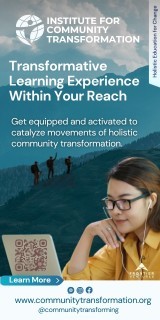Short Termers and the Future of American Missions
A mobilization strategy for the local church in the 21st century

During the 1980s and '90s in the United States, due to the maturing of the Baby Boomer population, it has been observed that a polarization of sorts has developed, in which more missiologically conservative local churches have tended to take a missions-as-process approach, whereas more methodologically progressive local churches have tended to take a missions-as-project approach.
This apparent polarization may describe reality, but both approaches have obvious inherent strengths and limitations. The missions-as-project approach capitalizes on directing present Boomer energy into vision trips, vacations with a purpose, major designated projects and offerings, short-termers, and ministry teams. But this approach admittedly has no long-term track record or guarantee of success. The missions-as-process approach draws upon over 200 years of Protestant missions history worldwide. But that approach has demonstrated a lack of flexibility, vision, strategic focus, entrepreneurial freedom, and networking capability.
Missions-as-process churches should not look with disdain on missions-as-project churches, which focus on vision trips, major projects, and short-termers. Nor should the missions-as-project churches be frustrated with the missions-as-process churches, which are concerned about church planting, strategies, track records, doctrinal statements, and long-term associations. The fact is, there is a strategy which I have used as a missions pastor in three local churches in over 28 years of ministry which synthesizes the strengths of both approaches. This strategy makes the short-termer (one who serves for one to two years) the cornerstone of its "game plan," satisfying the missions-as-project crowd, while at the same time having as its most obvious long-term feature the placement of career workers (those who serve for two to four terms) in the most strategic overseas assignments, satisfying the missions-as-process crowd. This strategy can work for any kind of evangelical church, whether it is new or old, large or small, experienced or inexperienced, urban, suburban, or rural. Let me explain, step by step, how I have implemented this strategy in my own church. Here are the ten steps you should follow:
First, make the short-term experience the centerpiece of your church's missions program. Switch; don't fight. The short-term movement is here to stay and is an obvious grassroots movement that is still growing every year. Go where God is working. But make the short-term experience work for you, rather than at cross-purposes to your church's program.
Second, establish a clear vision statement and work out a strategic and tactical plan for your church's missions program. This will take some time, but it is the single most important thing you can do. Make it clear enough that any 8th grader can understand it.
Third, infuse your missions budget (whether it is "faith promise" or "unified") with a onetime cash allocation. It could be $25,000 or $250,000. The amount doesn't matter. It only needs to be large enough to fully support at least one missionary unit for one year.
Fourth, set up a candidate training program that begins to sort your potential candidates into your "class of '98," your "class of '99," and so on. This way you are already thinking 2-4 years ahead as to who may get sent. It helps the planning process tremendously.
Fifth, in sending out your first short-termer, (assuming he/she is fully prepared for the assignment), pick up everything that that missionary unit lacks in support to get to the field. The figure could be 30 percent, 60, or even 100 percent of the total support needed. Why do I say this? Most churches and individuals are hesitant to support someone only going as a missionary for one or two years. Also, Boomers hate to ask for money--many would rather not go than ask for funds. So make it easy for everyone involved--just take responsibility yourself and get them to the field as fast as possible. (Not that much money is needed since short-termers usually don't raise money for cars, retirement, and other large-ticket items.) Use the money in the new account to get them to the field quickly since it doesn't make sense to force Boomers to spend 22 months raising support to go on a short-term assignment.
Sixth, send your short-termer to an area that is at least compatible with your long-term strategic plan or even a direct extension of it. Try to send them to the place and with the organization they might go with long-term. That way, whether your short-termers go long-term or not, they still will be forwarding key ministries that you church feels very strongly about. It's a win-win situation for everyone.
Seventh, when your short-termers return home, use their experiences to assess their call to the ministry, their personal vision, ministry skills, theological depth, language-learning aptitudes, organizational compatibility, and cross-cultural adjustments. Only a short-term experience can provide you with that kind of assessment. Vision trips and summer ministries don't allow the participants to experience culture shock--they don't have to set up house, learn a language, shop, renew visas--like short-termers do, since the shock doesn't hit until 6 months to 18 months into the experience. (One of the main reasons for missionary attrition during or at the end of the first term is the unrealistic expectations that the vision trip or summer ministry set up in the new missionary's mind that the short-term experience would have tempered or balanced). Don't underestimate the value of the two-year short-term experience.
Eighth, some short-termers will not go back to the field as long-term missionaries. Put their annual budget allocation back into next year's budget. Others will want to go back, but not immediately. They first may need to get more schooling, pay off debts, get married, or get more ministry experience or training. Put their annual budget allocation back into next year's budget, too. Use those funds for supporting those in your "class of '99."
Ninth, those short-termers who desire to return long-term immediately (within the next six months) now have fire in their belly. They can speak articulately and with passion. They have the war stories and the video footage. They now don't mind so much raising support, and others view them as returning veterans, not untried rookies. They can now go to other churches to raise support and can raise it relatively easily. Your church can now reduce the monthly allotment you were giving them, since other support is coming in - put the unneeded funds back into your "starter fund" for next year's short-termers. I have never seen a situation in over 25 years where a church, following this plan, gave more monthly support to long-termers than was given to them as short-termers.
Tenth, about half of your short-termers will not go back long-term; about a fourth will go back long-term, but not immediately; and about a fourth will go back long-term immediately. You will be able to use most of the funds from last year's short-term account to send out new candidates next year. You may need to add $5,000 or $10,000 more each year, but not much (this could be viewed as your budget's inflation-adjusted 5% annual increase). Every year those same funds are there to keep your church's missions vision expanding and maturing.
In conclusion, in this paradigm synthesis, the short-term missionary, the cornerstone-feature of the missions-as-project approach, becomes the single greatest driving force in mobilizing the local church for world missions. At the same time, the short-termer stream becomes the single greatest conduit for flooding the world with field-tested, strategic thinking, and adequately supported long-term missionaries, the hallmark of the missions-as-process approach. Don't allow your church to become artificially polarized by one valid approach alone. Use them both in tandem, minimizing the limitations of both by maximizing the strengths of both. That way your church can stay missiologically conservative and still be methodologically progressive. The future of the role of American churches in the cause of world missions in the 21st century is bright if short-termers are viewed with these bifocal lenses.
Dr. Monroe Brewer has served as the Global Ministries Pastor at Crystal Evangelical Free Church in New Hope, Minnesota since 1994. He is also adjunct professor at Trinity Evangelical Divinity School, and the academic dean for the Center of Biblical Training at Crystal Free Church. He has taught at 11 Bible colleges and seminaries, traveled to over 100 countries and has a doctorate in missiology and adult education.







comments